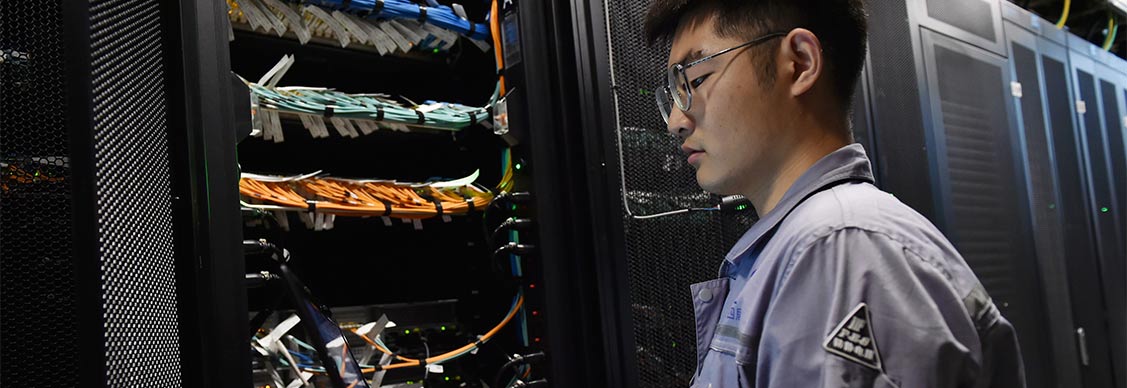There’s a labor shortage at data centers
Augmented reality used to train desperately needed workers
An increasingly digital world is demanding more data storage, network reliability and quick fixes when bugs arise. When mistakes are made and outages occur, the impacts are immediate.
Case in point: when Fastly, a content delivery company, went offline on June 8, people were unable to access The New York Times, Reddit and other popular websites around the world. It even sent U.S. stock futures down temporarily.
Because of the increasing demand for cloud storage and how intimately its functioning impacts people’s daily lives, data center construction is booming in areas across the globe and acquisitions are rising. For instance, Blackstone recently announced plans to buy QTS Realty Trust for roughly US$7 billion.
But a global shortage of the skilled employees who run data center facilities is causing headaches for companies concerned that the competitive environment — which has companies paying high salaries to poach facilities management staff — could interrupt their operations.
Half of data center operators surveyed by the Uptime Institute in 2020 said they were currently experiencing difficulties finding candidates for open positions, up from 38% in 2018. Data centers will need to hire 300,000 more staff by 2025, according to the Uptime Institute report, which said, “the lack of specialist staff will be an increasing concern for all types of data centers, from mega-growth hyperscale to small, private enterprise facilities.”
While the shortage has been intensified by the digital transformations during the pandemic, the real issue lies in the high volume of facilities management staff reaching retirement age, with a further wave expected to retire in coming years, says Bryon Price, Global Director, Technical Training, JLL. Meanwhile, younger generations receive less education in the trades and are less likely to take jobs in the rural areas where hyperscale centers are located.
The solution, experts say, is a massive training effort to bring new workers into the field for high-demand roles such as technicians, analysts of power systems, control specialists and robotics managers.
“The shortage is dire and data center operators’ stress levels are high,” Price says. “We had a client recently reach out to us in an attempt to get a handle on regional salary ranges for engineers because their staff are being poached left and right by co-locators and hyperscalers. This is exactly why we’ve developed a training program to get new workers skilled in this trade and are partnering with high schools and universities to bring more people into the field.”
Looking for more insights? Never miss an update.
The latest news, insights and opportunities from global commercial real estate markets straight to your inbox.
The cost of the shortage
When experienced and qualified people are poached from an organization, it adds another level of difficulty to running operations, says Duy Tu, Facilities Engineering & Operations Manager, Intel.
It can take an experienced and knowledgeable individual many months or even years “to learn the systems of a critical environment because of the complexity in controls, redundancy and back-up capabilities,” he says.
“That knowledge and understanding is honed over many years solving the facilities problems,” Tu says. “When that experienced person walks out of the door, it usually leaves a huge gap in operational capabilities and exposes the organization to reliability risks.”
It behooves any organization to identify these critical skill sets and individuals that possess them, compensate them fairly and create a work environment that they want to stay with, Tu says.
“The cost of keeping these individuals is a lot less than the cost of losing them,” he says.
Training and augmented reality
While data center staffing positions often list a high level of education as a prerequisite, not all roles truly demand such formal qualifications, Price says.
However, on the flip side, hiring inexperienced staff could lead to mistakes that take the cloud offline. For this reason, companies are investing in training programs. The Uptime study found that globally, the biggest employers are investing in more training and education, not just via internal programs but also by working with universities and technical schools.
An innovative option for trainings? Augmented Reality (AR).
“I created a customized training program using AR goggles,” Price says. “This allows me to give them hands-on experience without actually bringing them into the facility where their mistakes have greater consequences, and also to guide them within the facility itself. It’s hard to press the wrong button when you have an arrow pointing to your next step — and I can easily draw that arrow live with the person using AR.”
Additional bandwidth could also lie in more diverse recruiting. Women make up less than five percent of overall data center staff, according to the Uptime report, which also found that only one in four data centers have programs in place to recruit more women.
“Training programs that recruit a diverse pool of workers is the only way forward,” Price says. “Training these skilled workers will lessen the toll on current facilities management staff and reduce errors that lead to outages like the ones recently in headlines.”
